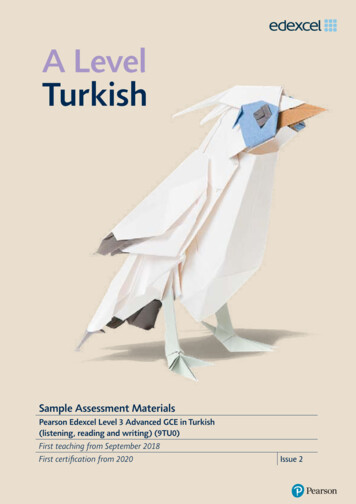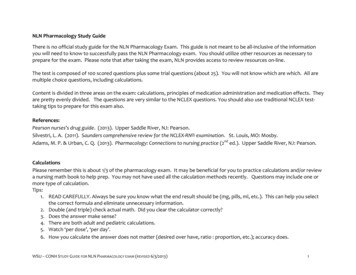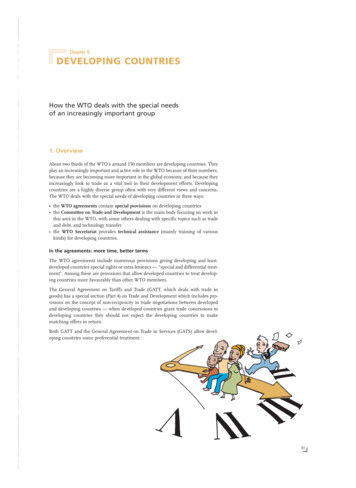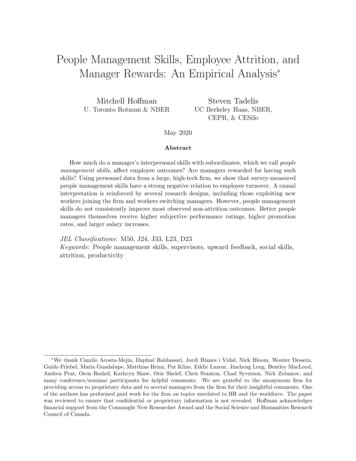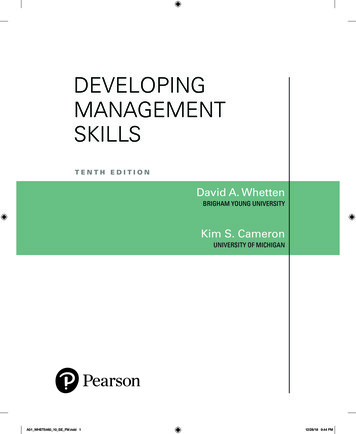
Transcription
DEVELOPINGMANAGEMENTSKILLSTENTH EDITIONDavid A. WhettenBRIGHAM YOUNG UNIVERSITYKim S. CameronUNIVERSITY OF MICHIGANA01 WHET5460 10 SE FM.indd 112/28/18 9:44 PM
Vice President, Business, Economics, and UKCourseware: Donna BattistaDirector of Portfolio Management: Stephanie WallSpecialist Portfolio Manager: Kris Ellis-LevyEditorial Assistant: Amanda McHughVice President, Product Marketing: Roxanne McCarleySenior Product Marketer: Carlie MarvelProduct Marketing Assistant: Marianela SilvestriManager of Field Marketing, Business Publishing:Adam GoldsteinField Marketing Manager: Nicole PriceVice President, Production and Digital Studio, Artsand Business: Etain O’DeaDirector, Production and Digital Studio, Businessand Economics: Ashley SantoraManaging Producer, Business: Melissa FeimerSenior Content Producer: Claudia FernandesOperations Specialist: Carol MelvilleDesign Lead: Kathryn FootManager, Learning Tools: Brian SuretteLearning Tools Strategist: Michael TrinchettoManaging Producer, Digital Studio and GLP:James BatemanManaging Producer, Digital Studio: Diane LombardoDigital Studio Producer: Monique LawrenceDigital Studio Producer: Alana ColesFull Service Project Management, Interior Design,Cover Design: Integra Software Services Pvt Ltd.Printer/Binder: LSC Communications, Inc.Cover Printer: Phoenix ColorCopyright 2020, 2016, 2011 by Pearson Education, Inc. or its affiliates. All Rights Reserved. Manufactured in theUnited States of America. This publication is protected by copyright, and permission should be obtained from the publisher priorto any prohibited reproduction, storage in a retrieval system, or transmission in any form or by any means, electronic, mechanical, photocopying, recording, or otherwise. For information regarding permissions, request forms, and the appropriate contacts withinthe Pearson Education Global Rights and Permissions department, please visit www.pearsoned.com/permissions/.Acknowledgments of third-party content appear on the appropriate page within the text.PEARSON, ALWAYS LEARNING, and MYLAB are exclusive trademarks owned by Pearson Education, Inc. or its affiliates in the U.S.and/or other countries.Unless otherwise indicated herein, any third-party trademarks, logos, or icons that may appear in this work are the property of theirrespective owners, and any references to third-party trademarks, logos, icons, or other trade dress are for demonstrative or descriptivepurposes only. Such references are not intended to imply any sponsorship, endorsement, authorization, or promotion of Pearson’sproducts by the owners of such marks, or any relationship between the owner and Pearson Education, Inc., or its affiliates, authors,licensees, or distributors.Library of Congress Cataloging-in-Publication Data is available on file at the Library of Congress.119ISBN 10:0-13-517546-1ISBN 13: 978-0-13-517546-0A01 WHET5460 10 SE FM.indd 212/28/18 9:44 PM
B R I E F TA B L E O F C O N T E N T SPreface xviiIntroduction 1PART I123Developing Self-Awareness 37Managing Stress and Well-Being 83Solving Problems Analytically and CreativelyPART II4567PERSONAL SKILLS 35131INTERPERSONAL SKILLS 185Building Relationships by Communicating SupportivelyGaining Power and Influence 225Motivating Performance 261Negotiating and Resolving Conflict 307PART III187GROUP SKILLS 3698 Empowering and Engaging Others 3719 Building Effective Teams and Teamwork 40510 Leading Positive Change 445Appendix I Glossary 487Appendix II References 497Index 521iiiA01 WHET5460 10 SE FM.indd 312/28/18 9:44 PM
A01 WHET5460 10 SE FM.indd 412/28/18 9:44 PM
CONTENTSPrefacexviiINTRODUCTION1THE CRITICAL ROLE OF MANAGEMENT SKILLSThe Importance of Competent Managers 4The Skills of Effective Managers 5What Are Management Skills? 7Improving Management Skills 8An Approach to Skill Development 8Leadership and Management 9Contents of the Book 11Organization of the Book 13Diversity and Individual Differences 14Summary314SUPPLEMENTARY MATERIAL 15Diagnostic Survey and Exercises 15Personal Assessment of Management Skills (PAMS) 15What Does It Take to Be an Effective Manager? 19SSS Software In-Basket Exercise 21SCORING KEY AND COMPARISON DATA 32Personal Assessment of Management Skills 32Scoring Key 32Comparison Data33What Does It Take to Be an Effective Manager?SSS Software In-Basket Exercise 33PART I133PERSONAL SKILLS 35DEVELOPING SELF-AWARENESSSKILL ASSESSMENT 38Diagnostic Surveys for Developing Self-AwarenessDeveloping Self-Awareness 383738The Defining Issues Test 38vA01 WHET5460 10 SE FM.indd 512/28/18 9:44 PM
Cognitive Style Indicator 41Tolerance of Ambiguity Scale 42Core Self-Evaluation Scale (CSES) 43SKILL LEARNING 44Key Dimensions of Self-Awareness 44The Enigma of Self-Awareness 44The Sensitive Line 45Understanding and Appreciating Individual Differences 46Important Areas of Self-Awareness 46Emotional Intelligence 48Values and Character StrengthsEthical Decision-Making 55Cognitive Style 57Attitudes Toward Change 59Core Self-Evaluation 61SUMMARY5062SKILL ANALYSIS 65Cases Involving Self-AwarenessThe Case of Heinz 65Computerized Exam 66Decision Dilemmas 6765SKILL PRACTICE 69Exercises for Improving Self-Awareness Through Self-Disclosure 69Shipping the Part 69Through the Looking Glass 69Diagnosing Managerial Characteristics 71An Exercise for Identifying Aspects of Personal Culture: A Learning Plan and A utobiographySKILL APPLICATION 75Activities for Developing Self-AwarenessSuggested Assignments 75Application Plan and Evaluation737576SCORING KEYS AND COMPARISON DATAThe Defining Issues Test 7777Escaped Prisoner 77The Doctor’s Dilemma 78The Newspaper 78Cognitive Style IndicatorScoring Key 79Comparison Data7979Tolerance of Ambiguity ScaleScoring Key 79Comparison Data7980Core Self-Evaluation Scale80Scoring Key 80Comparison Data 81Discussion Regarding the Case of Heinz 81Discussion Regarding the Shipping the Part Case 82vi ContentsA01 WHET5460 10 SE FM.indd 612/28/18 9:44 PM
2MANAGING STRESS AND WELL-BEINGSKILL ASSESSMENT 84Diagnostic Surveys for Managing Stress and Well-BeingManaging Stress and Well-Being 84Social Readjustment Rating ScaleSocial Readjustment Rating ScaleSources of Personal Stress 87Flourishing Scale 8883848486SKILL LEARNING 88Managing Stress and Fostering Well-BeingMajor Elements of Stress 8988Coping with Stress 90Managing Stressors 92Eliminating Stressors 93Eliminating Time Stressors Through Time Management 93Eliminating Encounter Stressors Through Community, Contribution, and Emotional Intelligence 98Eliminating Situational Stressors Through Work Redesign 101Eliminating Anticipatory Stressors Through Prioritizing, Goal Setting, and Small Wins 102Developing Resiliency and Well-BeingLife Balance104104Temporary Stress-Reduction TechniquesSUMMARY109110SKILL ANALYSIS 112Cases Involving Stress Management112The Turn of the Tide 112The Case of the Missing Time 115Stress and the Millennial Generation 118SKILL PRACTICE 120Exercises for Long-Term and Short-Term Stress Management and Well-Being 120The Small-Wins Strategy 120Life-Balance Analysis 122Deep Relaxation 123Monitoring and Managing TimeGeneralized Reciprocity 126SKILL APPLICATION 127Activities for Managing Stress125127Suggested Assignments 127Application Plan and Evaluation128SCORING KEYS AND COMPARISON DATASocial Readjustment Rating Scale 129Comparison Data129Sources of Personal StressFlourishing Scale 130Comparison Data129129130Contents A01 WHET5460 10 SE FM.indd 7vii12/28/18 9:44 PM
SOLVING PROBLEMS ANALYTICALLY AND CREATIVELY3SKILL ASSESSMENT 132Diagnostic Surveys for Creative Problem-SolvingProblem-Solving, Creativity, and InnovationSolving Problems Analytically and Creatively132132132How Creative Are You? 132Innovative Attitude Scale 134Creative Style Assessment 135SKILL LEARNING 137Problem-Solving, Creativity, and InnovationSteps in Analytical Problem-Solving 137131137Defining the Problem 137Generating Alternatives 138Evaluating Alternatives 139Implementing the Solution 139Limitations of the Analytical Problem-Solving ModelImpediments to Creative Problem-Solving 140Multiple Approaches to Creativity 141Conceptual Blocks 144Percy Spencer’s Magnetron 145Spence Silver’s Glue 146The Four Types of Conceptual Blocks140146Review of Conceptual Blocks 154Conceptual Blockbusting 154Stages in Creative Thought 154Methods for Improving Problem DefinitionWays to Generate More Alternatives 159International Caveats 162Hints for Applying Problem-Solving TechniquesFostering Creativity in Others 163Management PrinciplesSUMMARY155163163167SKILL ANALYSIS 169Cases Involving Problem-SolvingChip and Bin 169Creativity at Apple 172169SKILL PRACTICE 174Exercises for Applying Conceptual Blockbusting174Individual Assignment—Analytical Problem-Solving (10 minutes) 174Team Assignment—Creative Problem-Solving (20 minutes) 175Moving Up in the Rankings 176Elijah Gold and His Restaurant 177Creative Problem-Solving Practice 180SKILL APPLICATION 181Activities for Solving Problems CreativelySuggested Assignments 181Application Plan and Evaluationviii181181 ContentsA01 WHET5460 10 SE FM.indd 812/28/18 9:44 PM
SCORING KEYS AND COMPARISON DATAHow Creative Are You? 182182Scoring Key 182Comparison Data 184Innovative Attitude ScaleComparison Data184184Creative Style AssessmentScoring Key 184Comparison Data 184PART II4184INTERPERSONAL SKILLS 185BUILDING RELATIONSHIPS BY COMMUNICATING S UPPORTIVELY 187SKILL ASSESSMENT 188Diagnostic Surveys for Supportive CommunicationSKILL LEARNING 188Building Positive Interpersonal Relationships188The Importance of Effective Communication190High-Quality Connections 189The Key 190Communication Problems191What is Supportive Communication?Coaching and Counseling 193188191Defensiveness and Disconfirmation194Principles of Supportive Communication195Supportive Communication Is Based on Congruence, Not Incongruence 195Supportive Communication Is Descriptive, Not Evaluative 196Supportive Communication Is Problem-Oriented, Not Person-Oriented 198Supportive Communication Is Validates Rather Than Invalidates Individuals 199Supportive Communication Is Specific (Useful), Not Global (Nonuseful) 201Supportive Communication Is Conjunctive, Not Disjunctive 202Supportive Communication Is Owned, Not Disowned 202Supportive Communication Requires Supportive Listening, Not One-WayMessage Delivery 203The Personal Management InterviewInternational Caveats 211SUMMARY208211SKILL ANALYSIS 213Cases Involving Building Positive RelationshipsFind Somebody Else 213Rejected Plans 214213SKILL PRACTICE 216Exercises for Diagnosing Communication Problems and Fostering Understanding 216United Chemical Company 216Byron vs. Thomas 218Active Listening Exercise 220Contents A01 WHET5460 10 SE FM.indd 9ix12/28/18 9:44 PM
SKILL APPLICATION 222Activities for Communicating SupportivelySuggested Assignments 222Application Plan and Evaluation222223SCORING KEYS AND COMPARISON DATA5224GAINING POWER AND INFLUENCESKILL ASSESSMENT225226SKILL LEARNING 226Building a Strong Power Base and Using Influence WiselyGaining Power: Polarized Perspectives 227Opportunities for Gaining Power226230Sources of Personal Power 230Sources of Positional Power 235Transforming Power into Influence239Influence Strategies: The Three Rs 239The Pros and Cons of Each Strategy 241Exercising Upward Influence—A Special Case Of The Reason StrategyActing Assertively: Neutralizing Influence AttemptsThe Special Case of Sexual HarassmentSUMMARY247243245247SKILL ANALYSIS 251Case Involving Power and InfluenceDynica Software SolutionsSKILL PRACTICE 252Exercise for Gaining Power251251252Repairing Power Failures in Management Circuits 252Exercise for Using Influence EffectivelyKalina Ivanov’s Proposal254253Exercises for Neutralizing Unwanted Influence AttemptsCindy’s Fast Foods 2559:00 to 7:30 256SKILL APPLICATION 257Activities for Gaining Power and InfluenceSuggested Assignments 257Application Plan and Evaluation257258SCORING KEYS AND COMPARISON DATA6259MOTIVATING PERFORMANCESKILL ASSESSMENT254261262SKILL LEARNING 262Increasing Motivation and Performance 262Understanding the Prerequisites for Successful Task Performance 263x ContentsA01 WHET5460 10 SE FM.indd 1012/28/18 9:44 PM
Fostering High Performance 264Strengthen the Motivation S Performance Link265Strengthen the Performance S Outcomes Link269Expectations and GoalsAbility 267265Extrinsic Reinforcement 270Intrinsic Reinforcement 275Strengthen the Outcomes S Satisfaction Link279Human Needs 279Reward Salience 280Reward Equity 282Diagnosing and Correcting the Causes of Unacceptable Performance 283Diagnostic Framework 283Benefits of the E-A-M ApproachSUMMARY284285SKILL ANALYSIS 288Case Involving Motivation ProblemsElectro Logic288288SKILL PRACTICE 295Exercises for Diagnosing Work Performance ProblemsJoe Chaney 295Motivating Performance Assessment 296Exercise for Assessing Job CharacteristicsJob Diagnostic Survey297SKILL APPLICATION 300Activities for Fostering PerformanceSuggested Assignments 300Application Plan and Evaluation297300301SCORING KEYS AND COMPARISON DATAMotivating Performance Assessment 303Scoring Key7302303Job Diagnostic SurveyScoring Key295304304NEGOTIATING AND RESOLVING CONFLICTSKILL ASSESSMENT307308SKILL LEARNING 308The Pervasiveness of Organizational ConflictNegotiating Effectively 309Types of Negotiation 309The Basics of Negotiation 310Keys to Effective Integrative NegotiationResolving Conflicts Successfully308311313Understanding Different Types of Conflict 313Selecting the Appropriate Conflict Management ApproachChoosing the Appropriate Approach 319Personal Preferences 319Situational Factors 320317Contents A01 WHET5460 10 SE FM.indd 11xi12/28/18 9:44 PM
Using Collaboration to Resolve People-Focused Confrontations 321Initiator 322Responder 325Mediator 327All Roles 330SUMMARY330SKILL ANALYSIS 334Case Involving Interpersonal ConflictEducational Pension Investments334334SKILL PRACTICE 338Exercise for Negotiating 338A Home by the Sea 338Negotiation Planning Document340Exercises for Diagnosing Sources of ConflictSSS Software Management Problems341341Exercises for Selecting an Appropriate Conflict Management Strategy 350The Red Cow Grill 350Avocado Computers 351Phelps Inc. 351Exercises for Resolving Interpersonal Confrontations352Sabrina Moffatt 352Can Larry Fit In? 356Meeting at Hartford Manufacturing Company357SKILL APPLICATION 363Activities for Improving Managing Conflict Skills363Suggested Assignments 363Application Plan and Evaluation365SKILL PRACTICE Exercises for Resolving Interpersonal Confrontations 366SCORING KEYS AND COMPARISON DATAPART III8368GROUP SKILLS 369EMPOWERING AND ENGAGING OTHERSSKILL ASSESSMENT371372SKILL LEARNING 372Empowering and Engaging Others 372The Meaning of Empowerment 373Dimensions of Empowerment 374Self-Efficacy 374Self-Determination 375Personal Consequence 375Meaning 376Trust 376Review of Empowerment Dimensions 377xii ContentsA01 WHET5460 10 SE FM.indd 1212/28/18 9:44 PM
How to Develop Empowerment378A Clear Goal 378Fostering Personal Mastery Experiences 379Modeling 379Providing Support 379Emotional Arousal 380Providing Information 380Providing Resources 381Connecting to Outcomes 381Creating Confidence 382Review of Empowerment Principles 383Inhibitors to Empowerment385Attitudes about Subordinates 385Personal Insecurities 385Need for Control 385Overcoming Inhibitors 386Fostering Engagement386Deciding When to Engage Others 387Deciding Whom to Engage 388Deciding How to Engage Others 389Review of Engagement Principles 391International CaveatsSUMMARY391392SKILL ANALYSIS 394Cases Involving Empowerment and EngagementMinding the Store 394Changing the Portfolio 395SKILL PRACTICE 396Exercises for Empowerment394396Executive Development Associates 396Empowering Ourselves 400Deciding to Engage Others 401SKILL APPLICATION 402Activities for Empowerment and EngagementSuggested Assignments 402Application Plan and Evaluation402403SCORING KEYS AND COMPARISON DATA9404BUILDING EFFECTIVE TEAMS AND TEAMWORKSKILL ASSESSMENT 406Diagnostic Surveys for Building Effective TeamsTeam Development Behaviors 406Building Effective Teams and TeamworkAn Example of an Effective Team406406Diagnosing the Need for Team BuildingSKILL LEARNING 407The Advantages of Teams 407405406411Contents A01 WHET5460 10 SE FM.indd 13xiii12/28/18 9:44 PM
Team Development411The Forming Stage 412The Norming Stage 413The Storming Stage 415The Performing Stage 417Leading Teams420Developing Credibility 420Establish SMART Goals and Everest GoalsInternational Caveats 424Team Membership422425Advantageous Roles 425Unproductive Roles 428Providing Feedback 429International Caveats 430SUMMARY430SKILL ANALYSIS 431Cases Involving Building Effective TeamsLosing to a Weaker Foe 431The Cash Register Incident 433SKILL PRACTICE 435Exercises in Building Effective Teams431435Leadership Roles in Teams 435Team Diagnosis and Team Development ExerciseWinning the War for Talent 437Team Performance Exercise 439SKILL APPLICATION 441Activities for Building Effective TeamsSuggested Assignments 441Application Plan and Evaluation441441SCORING KEYS AND COMPARISON DATADiagnosing the Need for Team Building 442Comparison Data435442442Leadership Roles in Teams (Examples of Correct Answers)10 LEADING POSITIVE CHANGESKILL ASSESSMENT 446Diagnostic Surveys for Leading Positive ChangeLeading Positive Change 446443445446Reflected Best-Self Feedback 446SKILL LEARNING 448Ubiquitous and Escalating Change 449The Need for Frameworks 449A Framework for Leading Positive ChangeEstablishing a Climate of Positivity 454Creating Readiness for Change 458Articulating a Vision of Abundance 461xiv451 ContentsA01 WHET5460 10 SE FM.indd 1412/28/18 9:44 PM
Generating Commitment to the Vision 464Fostering Sustainability 466SUMMARY470SKILL ANALYSIS 472Cases Involving Leading Positive Change472Corporate Vision Statements 472Jim Mallozzi: Implementing Positive Change in Prudential Real Estate and Relocation 477SKILL PRACTICE 480Exercises in Leading Positive Change480Reflected Best-Self Portrait 480Positive Organizational Diagnosis ExerciseA Positive Change Agenda 482SKILL APPLICATION 483Activities for Leading Positive ChangeSuggested Assignments 483Application Plan and Evaluation483484SCORING KEYS AND COMPARISON DATAReflected Best-Self Feedback Exercise 485APPENDIX I GLOSSARY485487APPENDIX II REFERENCESINDEX481497521Contents A01 WHET5460 10 SE FM.indd 15xv12/28/18 9:44 PM
A01 WHET5460 10 SE FM.indd 1612/28/18 9:44 PM
P R E FA C EWhy Focus on Management Skill Development?Given that a “skill development” course requires more time and effort than a course usingthe traditional lecture/discussion format, we are sometimes asked this question by students, especially those who have relatively little work experience.Reason #1: It focuses attention on what effective managersactually do.In an influential article, Henry Mintzberg (1975) argued that management education hadalmost nothing to say about what managers actually do from day to day. He further faultedmanagement textbooks for introducing students to the leading theories about management while ignoring what is known about effective management practice. Sympatheticto Mintzberg’s critique, we set out to identify the defining competencies of effectivemanagers.Although no two management positions are exactly the same, the research summarized in the Introduction highlights ten personal, interpersonal, and group skills that formthe core of effective management practice. Each chapter addresses one of these skills:Personal Skills1. Developing Self-Awareness2. Managing Stress and Well-Being3. Solving Problems Analytically and CreativelyInterpersonal Skills4.5.6.7.Building Relationships by Communicating SupportivelyGaining Power and InfluenceMotivating PerformanceNegotiating and Resolving ConflictGroup Skills8. Empowering and Engaging Others9. Building Effective Teams and Teamwork10. Leading Positive ChangeConsistent with our focus on promoting effective management practice, thematerial in these chapters provides guidance for a variety of contemporary management challenges, including: “How can I help others accept new goals, new ideas, newxviiA01 WHET5460 10 SE FM.indd 1712/28/18 9:44 PM
approaches?” “How can I invigorate those who feel outdated and left behind?” “How doI help the ‘survivors’ of a downsizing pick up the pieces and move on?” “How do I helppeople with very different agendas and philosophies work together, especially during periods of high stress and uncertainty?”Anyone tempted to dismissively argue that the answers to these questions are “common sense” would do well to recall Will Rogers’ pithy observation: “Common sense ain’tnecessarily common practice.” In addition, the research reported in the Introductionsuggests that, in many cases, managers’ “common sense” isn’t necessarily “good sense.”The premise of this book and associated course is that the key to effective managementpractice is practicing what effective managers—those with “good sense”—do consistently.Reason #2: It is consistent with proven principles of effectiveteaching and learning.A seasoned university professor advised a young colleague, “If your students aren’t learning, you’re not teaching—you’re just talking!” Here’s what some authorities on highereducation have to say about how effective teachers foster learning:“All genuine learning is active, not passive. It is a process of discovery in which thestudent is the main agent, not the teacher.” (Adler, 1982)“Learning is not a spectator sport. Students do not learn much just by sitting in aclass listening to teachers, memorizing pre-packaged assignments, and spilling outanswers. They must talk about what they are learning, write about it, relate it topast experiences, apply it to their daily lives. They must make what they learn part ofthemselves.” (Chickering & Gamson, 1987)In their classic book, Bonwell and Elson (1991) list seven defining characteristics of activelearning:1. Students are involved in more than passive listening.2. Students are engaged in activities (e.g., reading, discussing, writing).3. There is less emphasis placed on information transmission and greater emphasis placed on developing student skills.4. There is greater emphasis placed on the exploration of attitudes and values.5. Student motivation is increased, especially in adult learners.6. Students receive immediate feedback from their instructor and peers.7. Students are involved in higher order thinking (analysis, synthesis, evaluation).Our goals in writing this book were to bridge the academic realm of theory and researchand the organizational realm of effective practice and to help students consistently translate proven principles from both realms into personal practice. To accomplish these goals,we formulated a five-step “active” learning model, described in the Introduction. Basedon the positive feedback we’ve received from teachers and students as well as multipleempirical research studies, we can state with confidence that the form of active learningpioneered in this book is a proven pedagogy for management skill mastery.MYLAB MANAGEMENT SUGGESTED ACTIVITIESFor the 10th edition we the authors are excited that Pearson’s MyLab Management hasbeen integrated fully into the text. These new features are outlined below. Making assessment activities available on line for students to complete before coming to class will allowyou the professor more discussion time during the class to review areas that students arehaving difficulty in comprehending.xviiiPrefaceA01 WHET5460 10 SE FM.indd 1812/28/18 9:44 PM
Watch ItMyLab recommends video clips that can be assigned to students for outside classroomviewing or that can be watched in the classroom. The videos correspond to the chaptermaterial and is accompanied by multiple choice questions that re-enforce student’s comprehension of the chapter content.Personal Inventory Assessments (PIA)Students learn better when they can connect what they are learning to their personalexperience. PIA (Personal Inventory Assessments) is a collection of online exercises designed to promote self-reflection and engagement in students, enhancing their ability toconnect with concepts taught in principles of management, organizational behavior, andhuman resource management classes. Assessments are assignable by instructors who canthen track students’ completions. Student results include a written explanation alongwith a graphic display that shows how their results compare to the class as a whole.Instructors will also have access to this graphic representation of results to promote classroom discussion.DETAILED CHAPTER BY CHAPTER CHANGESBased on suggestions from reviewers, instructors, and students, we have made a numberof changes in the tenth edition of Developing Management Skills.Introduction Updated references Clarified writing, especially sensitive to international perspectives and genderChapter 1 – Developing Self-Awareness Updated pre-assessment instruments, paying special attention to gender andnationality Updated references throughout the chapter Created new cases in the Skill Analysis section Updated scenarios in the Skill Practice sectionChapter 2 – Managing Stress and Well-Being Updated references throughout the chapter Added cases on stress and stress management among Millennials in the SkillAnalysis section Added an up-to-date Skill Practice exerciseChapter 3 – Solving Problems Analytically and Creatively Updated references and examples throughout the chapter Replaced cases in the Skill Analysis section Updated the Creative Problem-Solving Practice scenariosPreface A01 WHET5460 10 SE FM.indd 19xix12/28/18 9:44 PM
Chapter 4 – Building Relationships by CommunicatingSupportively Updated references throughout the chapter Updated cases in the Skill Analysis section Updated exercises in the Skill Practice sectionChapter 5 – Gaining Power and Influence Updated references throughout the chapterEnhanced material on social capitalAdded a section on Sexual HarassmentUpdated the cases in Skill Analysis sectionChapter 6 – Motivating Performance Adopted new chapter title, emphasizing the purpose of motivating othersUpdated references and examples throughout the chapterExpanded section on intrinsic reinforcementAdded section on diagnosing and correcting unacceptable performancesAdded new Skill Practice exerciseChapter 7 – Negotiating and Resolving Conflict Adopted new chapter title, reflecting expanded focusUpdated references and examples throughout the chapterAdded a section on negotiationsAdded new negotiations exercises in the Skill Practice sectionUpdated the cases and exercisesChapter 8 – Empowering and Engaging Others Updated references throughout the chapter Added a new case to the Skill Analysis section Updated exercises in the Skill Practice sectionChapter 9 – Building Effective Teams and Teamwork Updated references and examples throughout the chapter Created a new case in the Skill Analysis section Updated Skill Practice exercisesChapter 10 – Leading Positive Change Updated references throughout the chapter Updated Corporate Vision Statements in the Skill Analysis section Added an exercise to the Skill Practice sectionxx PrefaceA01 WHET5460 10 SE FM.indd 2012/28/18 9:44 PM
Tips for Getting the Most Out of This CourseWhether you are an undergraduate or MBA student, or an experienced manager, based onour years of teaching management skills, here are some suggestions for making this coursea personally meaningful learning experience: Read the Introduction carefully. Although this is not a typical management textbook, it is important that you understand its distinctive learner-focused features,especially the five-step learning model: Skill Assessment, Skill Learning, SkillAnalysis, Skill Practice, and Skill Application. You’ll also find informative researchon how much managers’ actions impact individual and organizational performance and the characteristics of effective managers. Thoughtfully complete the Skill Assessment surveys for each chapter. These diagnostic tools are designed to help you identify which specific aspects of each skilltopic most warrant your personal attention. Carefully study the Behavioral Guidelines and the summary model at theconclusion of the Skill Learning section of each chapter before reading thatsection. These written and graphical summaries are designed to bridge theresearch-informed description of each topic with the skill development activities that follow. To help you internalize research-informed “good sense,” besure to use the Behavioral Guidelines as your frame of reference when readingand discussing Skill Analysis cases and participating in Skill Practice and SkillApplication exercises. Be sure to complete the Skill Application exercises in each chapter. Managementskill mastery requires out-of-class skill practice. How to do this is pretty straightforward if you are currently working in an organization, regardless of whether youare an experienced manager or a new, part-time employee. Whether or not youare currently employed, we encourage you to seek out skill practice opportunitiesin all aspects of your life, including working in assigned teams in this and othercourses, planning social events for a campus or community organization, counseling a troubled sibling or friend, managing end-of-semester deadlines, or handling adifficult issue with a boy/girlfriend or spouse. The sooner you begin—and the moreyou persist in—practicing what you learn in this course, the more you’ll be able tocount on these skills as “automatic responses” when you need them as a manager.INSTRUCTOR RESOURCE CENTERAt Pearson’s Higher Ed catalog, https://www.pearsonhighered.com/sign-in.html, instructors can easily register to gain access to a variety of instructor resources available with thistext in downloadable format. If assistance is needed, our dedicated technical support team isready to help with the media
Temporary Stress-Reduction Techniques 109 SUMMARY 110 SKILL ANALYSIS 112 Cases Involving Stress Management 112 The Turn of the Tide 112 The Case of the Missing Time 115 Stress and the Millennial Generation 118 SKILL PRACTICE 120 Exercises for Long-Term and Short-Term Stress Managemen






